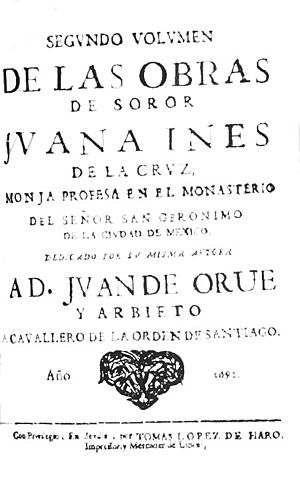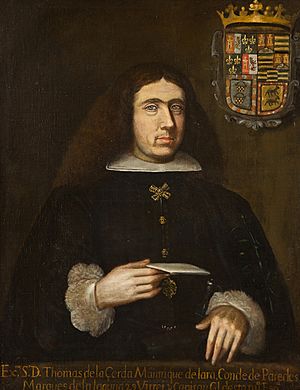House of Desires facts for kids
Los empeños de una casa (which means House of Desires) is a famous play written by Sor Juana Inés de la Cruz. She was a brilliant nun and writer. This play was first shown on October 4, 1683. It was part of a big birthday party for the son of the Viceroy, who was a very important leader in Mexico City. The play also celebrated the arrival of the new Archbishop of Mexico City.
This story is a comedy full of secrets and mix-ups. It's about two couples who want to be together but face many challenges. Los empeños de una casa is one of the most well-known plays from the late-Baroque period in Spanish-American literature. What makes it special is that the main character, Doña Leonor, is a strong and determined woman. She openly shares her feelings and desires, which was unusual for the time.
Many people believe this play is one of Sor Juana's best works. It's also considered a highlight in all Mexican literature. The way it handles secrets, complicated relationships, and city life makes it a unique play from colonial Latin America.
Contents
What is Los empeños de una casa About?
The Story Begins in Toledo
The play starts with Doña Ana and her brother Don Pedro moving from Madrid to Toledo for business. In Madrid, a man named Juan de Vargas falls in love with Doña Ana. He follows her to Toledo, where all the funny and confusing events happen.
In Toledo, Doña Ana thinks she is falling for Carlos de Olmedo. But Carlos doesn't love her back. He is in love with Doña Leonor de Castro. To make things even more complicated, Don Pedro wants to marry Doña Leonor himself!
A Secret Plan and New Arrivals
Leonor's father, Don Rodrigo, doesn't approve of her relationship with Carlos. So, Carlos and Leonor make a plan to run away together. They hope this will force her father to accept their marriage.
Soon, Ana finds out that she and Leonor love the same man. Then, Don Carlos and his servant Castaño arrive at Ana's house. They are running from the law. Ana kindly gives them a place to hide.
The plot gets even more tangled when Celia, Ana's trusted maid, also brings Juan de Vargas to stay at their house.
Confusions in the Dark
One night, in the dark, Juan scolds someone he thinks is Ana for not loving him. But he can't see, so he doesn't realize he's actually talking to Leonor! Carlos hears Juan's voice and leaves. Everyone ends up talking to the wrong person without knowing it.
When Celia brings a light, everyone is confused. Juan and Leonor mistakenly think that Ana is Carlos's secret lover. However, Carlos trusts Leonor completely, and his loyalty is a big part of the story.
More Mix-Ups and a Happy Ending
Carlos then sends his servant, Castaño, to explain the situation to Leonor's father. To avoid being recognized, Castaño puts on some of Leonor's clothes. This leads to even more funny mix-ups!
Dressed as Leonor, Castaño meets Pedro. Pedro is very confused by Castaño's strange behavior. At first, he thinks it's a joke about his beloved Leonor. Then, Castaño pretends to be Leonor and promises to marry Pedro that very night, hoping to escape.
After many humorous scenes where people are mistaken for others, the story ends happily for most characters. Carlos and Leonor get to be together. Ana and Juan also end up together, as do Castaño and Celia. However, Don Pedro remains single. This is seen as a punishment because he caused much of the trouble by trying to steal a woman who wasn't meant for him.
The Play's Special Occasion
Celebrating the Viceroy's Son
Sor Juana wrote The House of Desire to celebrate the birth of José. He was the son of Tomás de la Cerda y Aragón and María Luisa Manrique de Lara y Gonzaga. They were the Marquises of La Laguna and the Viceroys of New Spain. They were also very important supporters of Sor Juana.
The play was part of a big celebration. It included shorter performances that were closely linked to the main play. This made it hard to separate the celebration from the drama itself.
A Play for a Cultured Audience
The performance began with a special opening called a loa. This was for a well-educated audience who enjoyed grand plays, like those by Pedro Calderón de la Barca. The characters in the loa included Fortune, Diligence, Merit, Chance, and Joy. Even though the main goal was to celebrate the Viceroy's son, the play also congratulated Archbishop Aguiar. Sor Juana later had disagreements with him.
Throughout the play, Sor Juana included three songs to praise Lady María Luisa Manrique, whom she admired greatly. These songs were titled "Divine Lysi, Let Pass," "Beautiful María," and "Tender Beautiful Flower Bud." Each song had thirty-two verses, written in a style with eight syllables per line.
Insights into Palace Life
Between the first and second acts, a short play called Sainete primero de palacio was performed. In 202 verses, it showed life in the viceregal court from Sor Juana's unique point of view. She had experienced this life firsthand when Antonio Sebastián of Toledo was Viceroy.
The Segunda sainete (Second Interlude) was similar. Both of these short plays are important because they show what palace life was like back then. They also introduced a new theater trick in Spanish-American plays: using fake gossip on stage to represent public comments. The Segunda sainete also used the idea of a "play-within-a-play" and mentioned the big challenges of that time. It also referred to famous Spanish books, like La Celestina. Sor Juana even wrote the ending for a version of La Celestina by Agustín of Salazar and Torres. She also playfully teased another writer of her time, Francisco de Acevedo. Both sainetes show Sor Juana's cleverness and her love for Spanish theater.
A Dance of Nations and Hidden Meanings
House of Desire ends with a Sarao of Four Nations. This is a dance with three hundred sung verses. Spaniards, Italians, Mexicans, and Black citizens all dance and praise the important guests.
Some scholars believe that Sor Juana used this scene to subtly criticize parts of the colonial system. For example, the way different groups are shown dancing might hint at the social order in New Spain. Some think this led to her being told by her superiors to stop writing. This is similar to what happened to Friar Servando Teresa of Mier. He was also criticized after a controversial speech about the Virgin of Guadalupe in 1794.
Editions of the Play
Over the years, Los empeños de una casa has been published many times.
Early Printings
Some of the first editions were printed in the late 1600s and early 1700s. For example, a second volume of Sor Juana's works was published in Seville in 1692. It included The Efforts of A House and many other poems. Other early printings happened in Barcelona and Madrid.
Modern Collections
Today, you can find Los empeños de una casa in many modern collections of Sor Juana's complete works. These editions often include notes and introductions by experts to help readers understand the play better.
See also
 In Spanish: Los empeños de una casa para niños
In Spanish: Los empeños de una casa para niños
- Feminist Reading of the Work of Sor Juana Inés de la Cuz



